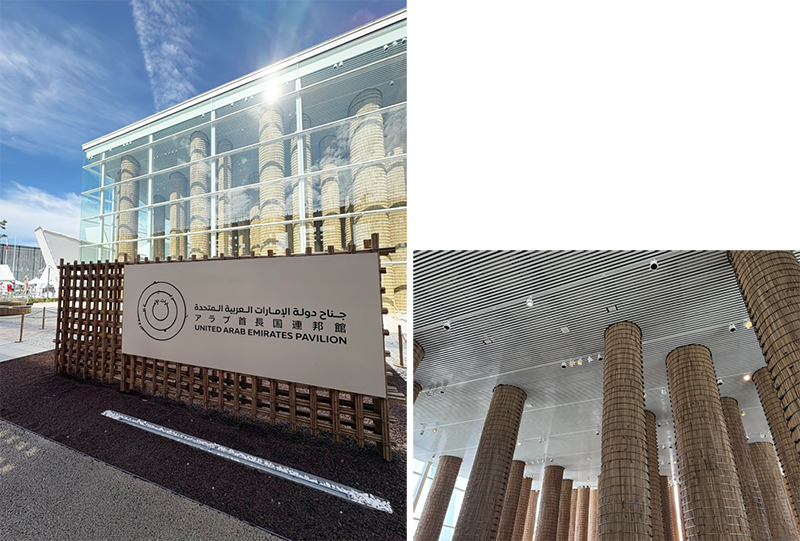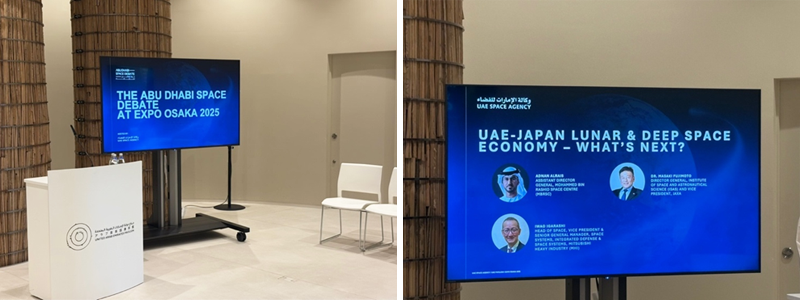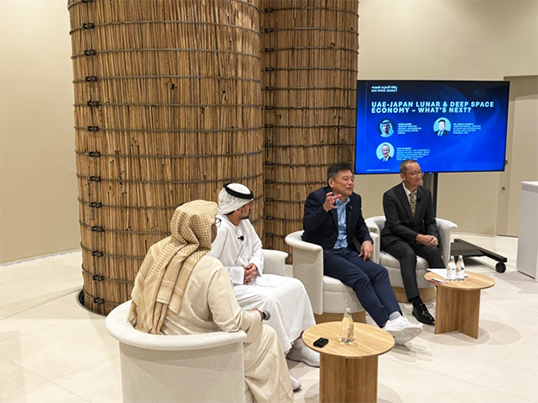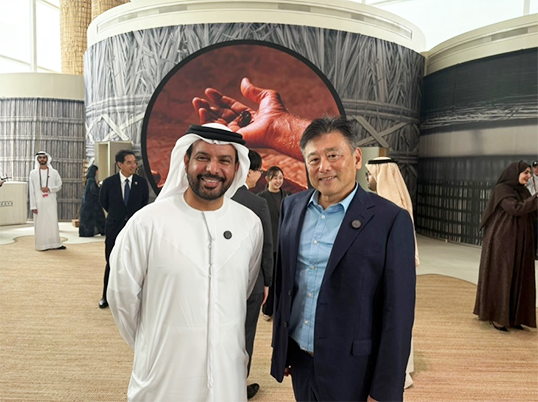Morning light filtered through the white walls of the UAE Pavilion, spreading softly as if it had traveled a long way from a desert sunrise. It warmed the still air of the hall in slow increments, like someone gently turning up the volume on an old record player. A faint cool breeze traced the floor, brushing past our feet and leaving behind small, restless shadows.
September 12, 2025. A Friday. But not an ordinary one.
Today were the day conversations about the Moon, Mars, and the vastness of deep space would unfold under the pavilion's high ceiling. The day when an opera celebrating Italy's National Day would drift across the fairgrounds, and the UAE Pavilion's exhibits would catch the light like a signal from the future. All of it happening at once, blending like travelers pausing at the same quiet station on a long journey.

A Session on the Space Economy: Looking Toward the Moon and Beyond
Inside the hall, the title projected on the screen read: UAE-Japan Lunar and Deep Space Economy ― What's Next?.
The moderator's voice was calm as he called the room to order. On stage sat three figures:
Mr. Adnan Al Rais, Assistant Director General of the Mohammed Bin Rashid Space Centre (MBRSC),
Dr. Fujimoto Masaki, Director General of ISAS, and
Mr. Igarashi Iwao, head of the Space Business Department at Mitsubishi Heavy Industries.

Before the session began, a basket of dates and steaming, fragrant Arabic coffee was passed around. The dates left a slight stickiness on my fingertips, a sweetness that unfolded slowly in the mouth. For a moment, I felt as if time from a far-off desert had seeped into Osaka and was flowing quietly through the room.

Mr. Al Rais spoke first, his voice steady, reflective.
"International space exploration no longer belongs to any single nation," he said. "Whether a country has a large program or is just beginning, everyone can contribute. Cooperation opens doors for the next generation of scientists and engineers." His words rose, touched the ceiling, and then slowly drifted down to settle into the room's air.
The moderator asked:
"How do ambitions for the Moon and deep space tie into national innovation and economic diversification?"
Mr. Al Rais nodded, was patient and unhurried.
"Lunar exploration drives innovation. It helps nations shift toward knowledge-based economies. Technologies like AI and advanced materials will spill over into fields far beyond space. And international partnerships ―satellites, Mars missions, lunar missions― they are essential everywhere."
In the front row, someone took notes. Another person smiled softly, as if hearing the distant sound of a ship preparing to leave port.

Then DG Fujimoto spoke quietly, but with an undercurrent of energy.
"Japan faces a declining population," he said. "But space can create high-quality jobs, jobs that excite young people. In deep-space exploration, we need higher autonomy ―and that is fun work. I believe we can offer the next generation something deeply meaningful."
A few heads in the audience nodded. The air seemed to soften. Perhaps the phrase fun work had surprised them. Smiles appeared here and there, spreading like ripples across a still pond. The words echoed off the high ceiling of the pavilion before drifting slowly back down into the audience. For a moment, the future was there, right in front of us ― the glow of lights on a lunar base, the horizon of Mars, young people in work suits moving with quiet determination.

Then Mr. Igarashi spoke, adding the view from industry.
"The relationship between the UAE and Japan has been strong for many years," he said.
"Since the 2000s we have worked together on many products and projects. Lunar exploration requires building complex systems and strong government leadership. The market is still immature, but there is room to grow."
The moderator posed the next question.
"What frameworks are needed to ensure a sustainable space economy?"
Mr. Igarashi paused for a moment before replying.
"Balancing innovation with responsibility is essential. We need international governance, environmental protection protocols, ethics for AI and autonomous systems, and shared standards."
DG Fujimoto followed.
"For sustainability, we must create an environment where venture companies can enter easily. Providing test facilities and reducing initial costs are key and it will help revitalize regional economies as well."
From somewhere in the back of the room, a small round of applause broke out. The words had gained a kind of temperature, something you could almost feel on your skin.

The final question came.
"What will be the most transformative opportunities for the lunar and deep-space economy in the next ten to twenty years?"
Mr. Al Rais smiled slightly before answering.
"Solar power generation.
Lunar habitation.
Commercial tourism.
Resource utilization.
They all require long-term investment, but we can build sustainable business models around them."
DG Fujimoto added softly, as though finishing a thought that had been waiting all along.
"Small, frequent missions will be the key. Lowering costs, increasing participation ― that will breathe life into deep-space exploration."

The air in the room lifted just a little, as if everyone had felt the same quiet shift. It was as though a small bridge toward deep space had just been laid down ―invisible, but real.
After the Session: Handshakes and New Temperature in the Air
When the session ended, DG Fujimoto clasped hands firmly with Director General Salem Butti Al Qubaisi. Their smiles carried a kind of release, as if the serious words from earlier had dissolved into something lighter.

Left: H.E. Salem Butti Al Qubaisi, Director General. Right: DG Fujimoto. Behind them, the exhibit stood quietly, as if it were holding a memory of the desert ― something faint but still alive, flickering in the background.
Later, DG Fujimoto met again with Minister Ahmed Belhoul Al Falasi ― whom he had seen just days before at Tsukuba Space Center ― and presented him with a flagship model of SORA-Q, the lander that had touched down on the Moon during the SLIM mission. The Minister took it in both hands, held it for a quiet moment, and smiled.

Left: H.E. Ahmed Belhoul Al Falasi, Minister of Sports and Chairman of UAESA. Right: DG Fujimoto, handing over the SORA-Q model. For a moment, time seemed to pause. The handoff was quiet, almost ceremonial ― as if a small piece of the Moon itself had changed hands.
For a second, it felt as if the temperature of the UAE-Japan partnership had risen, just enough for everyone in the room to notice.
Outside the Pavilion: A Student Waiting
Stepping outside to breathe in the air, we found a young man standing there. A badge on his chest read "UAE Pavilion Youth Ambassador." He said he studied space science at Tokai University.

DG Fujimoto asked him, instinctively:
"What made you decide to study space?"
The young man looked up toward the pale sky.
"I've loved looking at the stars since I was small," he said. "But when I hear about space, it feels like my own future opens up too."
His words stayed with me. Somewhere in the distance, children were laughing, and the pillars of the pavilion stretched their shadows a little longer across the ground. I thought: Yes. Today's conversations are reaching the next generation after all.
When we shook hands goodbye, his palm was damp with nervous sweat, but his grip was strong.
It felt like the hand of someone reaching toward space ― not just metaphorically, but for real.
Expo Collaboration Event: Opening the Future with Space Data
Later, we wandered over to the Future Life Village FLE Stage, where JAXA's First Space Technology Directorate was hosting a special event. The title read: Know, Understand, Predict, Act ― Opening the Future with Space Data.
On the stage, vast screens showed the newest data from spacecraft and Earth-observation satellites.
In the audience, people held tablets and phones, comparing live images side by side, their faces lit by the glow of the screens.
Children and university students let out small shouts of excitement ― the kind that rise before anyone has time to think, as if their voices had simply escaped into the air on their own.

The audience's reactions were simple, almost blunt.
"I could actually see the ocean getting warmer."
"The forest near where I used to live has changed!"
It was one thing to know these facts, but another to have them appear, alive, right in front of your eyes. Looking around, I thought I could see a faint mix of surprise ― and maybe a quiet sense of responsibility for the future ― passing across their faces.

Left: Rebecca Levy, NASA Asia Representative. Center: DG Fujimoto.
Rebecca Levy was there too, tapping lightly on a tablet as someone explained the data to her.
It felt like a quiet snapshot of international space cooperation ― no speeches, no ceremony, just people leaning in over a screen. Beside her, DG Fujimoto stood silently, watching, as if to let the moment breathe.
On the West Side of the Expo Grounds
The JAXA event took place on the western edge of the Expo site.
A breeze from the sea brushed lightly against my cheek, cool enough to make me blink.
Far off, Kobe's Port Island floated in the haze, a view that ― for some reason ― felt calming, almost like exhaling after holding your breath for too long. In a corner of the venue, we stopped to take a picture with Myaku-Myaku, the Expo's official mascot. For just a moment, I forgot this was a stage for international exchange. I felt simply like a visitor enjoying the Expo, nothing more.

DG Fujimoto stood beside Myaku-Myaku, the sea behind them. The light of the setting sun was soft, almost tender.
Walking Through the Expo: America, Italy, and a Bit of Twilight
Later that day, we visited the American Pavilion. We met William E. Grayson, the U.S. Commissioner General for Expo 2025, who spoke of Shohei Ohtani's feats ―which were being projected in the pavilion― and of the long history of U.S.-Japan space cooperation. DG Fujimoto and Vice President Takiguchi thanked him in turn. They shook hands, firmly.

From left to right: William E. Grayson, Commissioner General of the U.S. Pavilion at Expo 2025, DG Fujimoto, and Vice President Takiguchi.
Inside the hall, lunar rocks, the James Webb Space Telescope, and rocket systems stood proudly on display.

At the far end, a giant screen showed the rugged surface of asteroid Bennu, the destination of the NASA OSIRIS-REx mission ― a surface so rough it felt almost familiar.

Bennu's sample had arrived at ISAS in August 2024, and analysis is underway. Standing there, I was struck by the fact that two probes ―Hayabusa2 and OSIRIS-REx― had traveled their separate journeys and returned their samples home. International cooperation was no longer just an idea. It was there, in front of me, a real thing, inside a glass case.

A commemorative photo in front of the American Pavilion― DG Fujimoto on the right, Vice President Takiguchi, second from the right, and NASA Asia Representative Rebecca Levy on the left. All of them smiling, as if sharing a small secret with the camera.
Italy National Day: Arias Beneath the Shining Hat
As evening fell, DG Fujimoto moved to the "Shining Hat" venue in the center of the Expo for Italy's National Day event. The tenor stepped forward and sang the first note.
The sound pierced the ceiling, filled the air, and touched everyone in the audience at once.
Each note felt like it was being stitched into something larger ― a single, long melody.

I thought: Space might be like this too.
The Moon, Mars, deep space, each mission, each experiment, one note after another, building toward a long, unfinished song. When the encore ended, the audience rose to their feet. Applause rolled out like waves, climbing to the ceiling of the Shining Hat and echoing back down again.
The sound lingered just long enough to make you wish you could hear it all from the very beginning once more.
Visiting the Italy Pavilion: Where Technology Meets Art
After the event, DG Fujimoto toured the inside of the Italy Pavilion for a cultural reception hosted there. Stepping into the gallery, the first thing that struck him was Caravaggio's The Entombment of Christ. The whiteness of the skin against the darkness of the background was so stark that words failed him for a moment. It felt like staring at the boundary between light and darkness in space itself and somehow, it connected back to the day's discussions about deep-space exploration.
Deeper inside the pavilion, Leonardo da Vinci's Codex Atlanticus lay open, quiet and still. Peering at the pages, with their neat handwriting and intricate sketches, one could almost hear the breath of a mind from five centuries ago trying to solve the mysteries of nature and the cosmos. And somehow, it felt continuous with today's plans for exploring deep space.

On the Way Back
By nightfall, the massive wooden "Grand Roof Ring" still shone behind us, casting its glow on the walkways.
Holographic displays flickered in purples and blues as the wind moved through.

It occurred to me : Space science and exploration are, at their heart, a way of threading people together across nations, across languages. The dreams and technologies shared today will be passed down, like a quiet pulse "脈々(Myaku-Myaku)in Japanese", to the next generation. Someday they will meet again, on the Moon, on Mars, somewhere in deep space. And as I walked away from the Expo grounds, I felt certain a small bridge had been built toward that day.

A photo of Myaku-Myaku, bathed in the lights of night. Far in the distance, the Grand Roof Ring glowed softly. Together, they looked like a symbol from the future ― quiet, but unmistakable.
Bonus Episode: At the Tsukuba Space Center
Three days before the Expo event, the UAE delegation visited the Tsukuba Space Center. DG Fujimoto gave an overview of ISAS's missions, speaking in a calm, measured voice. Inside the Space Dome, Deputy Director Yuichi Tsuda stood before the life-size model of Hayabusa2 and spoke about the spacecraft's long journey and its return to Earth. His voice rose slowly to the dome's ceiling and came back down, settling somewhere deep in the listeners' chests.
Moments like this make me think:
Space is far away, yes ― but the words and stories that will carry us there are spun right here, on this ground.
When we stepped out of the dome, a breeze slipped past. The air was slightly damp, and in it I thought I could smell the faint scent of the next mission. It felt like the perfect prelude to the conversations that would follow at the Expo, just a few days later.

Right: H.E. Ahmed Belhoul Al Falasi, Minister of Sports and Chairman of UAESA. Left: JAXA President Yamakawa.
ISAS Deputy Director Tsuda bent slightly forward as he explained Hayabusa2, his voice quiet but clear, as if guiding everyone present along the spacecraft's journey.
(2025/10/06)

